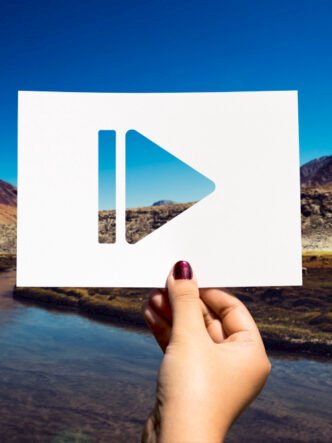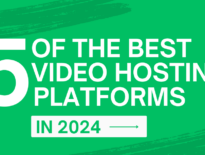Video on demand has become increasingly popular in the past years as technological advances fuel its growth. Some of the reasons why it has taken over modern entertainment are its convenience and accessibility. VOD platforms usually offer high definition content which results in a great viewing experience. Global VOD revenue is projected to reach US$245.50bn by 2028, and ad-based revenue isn’t included in this number. The widespread adoption of smartphones and connected devices means that VOD providers can reach larger audiences than ever before.

What is VOD?
Viewers can watch video on demand (VOD) whenever they choose rather than at a scheduled broadcast time. They can use various devices to access it and watch it at their own convenience. VOD platforms usually offer a wide variety of content to watch. With internet access videos can be streamed from anywhere so they are accessible to wide audiences.
How VOD works
- A publisher will upload a video to a server and make it available on a platform.
- The video is compressed to make it easier to send.
- A user requests to view the video using the publisher’s online video player.
- The video player forwards the request to the server.
- The server sends back the compressed video file which the player decompresses.
- The user watches the video.
Personalized recommendations: Viewers of VOD often receive personalized recommendations based on their viewing history. This enhances their experience by helping them discover new content that matches their preferences.
Live streaming and VOD: Live streaming is very popular today and any live show, event, or program can become VOD once it’s over. Publishers can host live streams on live stream platforms and viewers can watch in real time. They can then make that stream available as VOD afterward and even add interactive elements to make it more engaging.
Businesses can stream live events and some people will watch as the event takes place. Others who can’t view it in real time can watch it later at their own convenience. This offers businesses more monetization options.
VOD and OTT: These terms may be used interchangeably but they are different. VOD is tied to on-demand access to video content. OTT broadcasting relies on the internet rather than satellite or cable. OTT streaming services can offer VOD content.
Types of video on demand services
Video on Demand (VOD) has evolved to offer various models, catering to different user preferences and business strategies. Users can choose the model that best suits their budget and viewing habits. Here are the three primary types of VOD:
1. Subscription-based VOD (SVOD)
Many subscription video on demand services operate on a subscription model. Popular examples include Netflix, Amazon Prime Video, and Hulu. These platforms often provide ad-free viewing and allow multiple user profiles.
Users pay a regular subscription fee (monthly or annually) for access to a platform’s content library.
- SVOD services typically offer unlimited access to a wide range of content, including movies, TV shows, documentaries, and exclusive originals.
- SVOD is often more economical than traditional cable TV packages. It offers a wide range of content at a predictable cost. Publishers often have subscription plans at different price points.
2. Transactional VOD (TVOD)
TVOD allows users to purchase one-time or access for a limited time to a piece of content. Once they have accessed the video or the access timeframe has run out, they can’t watch the content again. Examples of TVOD platforms are iTunes and Google Play Movies. This is a good monetization model for pre-release access or premium content viewers can’t find elsewhere.
3. Ad-Supported VOD (AVOD)
AVOD platforms offer free content to viewers but include advertisements. An example of an AVOD platform is YouTube where users get free access to content if they don’t mind ad interruptions. Ads may show up before, during a video, or after a video stream.
Sometimes providers will use hybrid monetization models that may combine a lower-tier subscription fee and use ads.

Using VOD in education and business
VOD is not restricted to the entertainment world. It is also very useful in education and in business. This was evident during the COVID-19 pandemic when educators continued to conduct classes and lectures by using VOD. Students were able to access online courses and lectures. Virtual event software allowed for the streaming of online events as they couldn’t take place in person. VOD is still in high demand today and many events still take place online, proving that VOD streaming isn’t a passing phase.
Businesses can benefit a great deal from creating video on demand. They can turn a live stream into VOD to add to a content library. Using VOD in a content library can help them to:
- Reach a wider audience as viewers from all over the world can stream VOD content at any time from any device.
- Engage viewers after a live stream by allowing them to rewatch or share content.
- Repurpose live videos as VOD content for marketing, social media, etc. which reduces content production time.
- Monetize VOD content through paid memberships or subscriptions, pay-per-viewer, ad insertion, or viewer conversion.
Hosting a library of on-demand content on a business website can run up costs and slow down a website. Live streamers, online course creators, and content creators can benefit from using a video hosting platform that accommodates both live streaming and VOD.
A video hosting platform can streamline the uploading, storage, management, organization, and distribution of VOD content.
Cincopa is a video hosting platform that comes with all the solutions your business needs to use VOD effectively. It will help you to host, share and monetize your content all in one space. You are able to host your videos securely, manage your VOD library, and use advanced analytics to see how your VOD performs. An HTML5 player offers many customization and branding options. A CDN enables all viewers across the globe to see high-quality videos without buffering.
Video on Demand User Experience
The shift away from traditional broadcast methods to a more user-central approach is driven by advances in technology and changes in consumer preferences. VOD providers use cloud computing, CDNs, and other technologies like 5G connectivity to offer high-quality content to users. They prioritize the quality of the viewing experience and visual and audio quality often includes high-definition and 4K options.
Personalization
One of the most significant user-centric aspects of VOD is the ability to personalize the viewing experience. Unlike traditional TV schedules, VOD platforms allow users to watch what they want, when they want. This flexibility is particularly appealing in today’s fast-paced world, where consumers demand content that fits their schedules and preferences. The use of algorithms allows providers to offer VOD content recommendations based on viewing history.
Providers can also use data to create targeted video ads tailored to individual users. They can analyze user preferences to deliver ads that are more relevant and appealing to them instead of just producing generalized ads. In advertising, they must know how to balance respect for viewers and gaining their trust with the desire to make money. Personalized ads can be relevant and helpful.
Wide range of content
The use of cloud-based servers and storage means VOD providers can offer a wide range of content to viewers. Content libraries can cater for diverse interests and preferences. For example, with the advances in virtual event software, businesses can film online events and add them to VOD libraries for access at any time. The huge variety of content means everyone can find content that suits their tastes and interests. They can watch fashion shows, series, documentaries, music videos, sports, and much more.
- User-friendly interfaces: The design of VOD platforms is usually intuitive. User-friendly interfaces allow users to easily search for and discover new content.
- Content distribution network (CDN): Using a CDN while streaming helps to distribute video content to global viewers without latency or buffering issues.
- Adaptive bitrate streaming: This adjusts video quality according to device capacity and network conditions. Viewers can enjoy seamless playback.
- Privacy and security: VOD services offer greater privacy and control over viewing habits. Users can watch content without any broadcast restrictions. Security measures such as AES encryption and domain restrictions help to protect VOD content from unauthorized access.
- Analytics: You need to have access to in-depth analytics if you want to assess the performance of your VOD content. When you get insights from analytics, you can improve your content and make sure it offers the best user experience. You can even access live analytics as streaming takes place.

The future of VOD
VOD has changed consumer behavior forever. Consumers increasingly expect relevant content that they can access at any time, from anywhere, and in a format that suits their current needs. The VOD market is positioned for substantial growth and transformation. The landscape is likely to keep evolving as many global companies and regional players contribute to a varied media ecosystem.
Some of the challenges
Despite its advantages, VOD faces certain challenges. These include aspects such as content localization and licensing. Adhering to media censorship regulations and internet bandwidth limitations in some areas are other challenges. There must be a balance between the value of content and subscription costs. This puts pressure on VOD providers to keep offering up-to-date, relevant content. As technology continues to evolve, these challenges can present opportunities for innovation.
More use of artificial intelligence: AI is allowing VOD platforms to offer more intelligent recommendations. It has the ability to analyze huge amounts of data and make predictions. This can be incredibly useful in creating VOD.
Further adoption of cloud computing: Cloud computing is extending how much content VOD providers are able to offer.
More efficient automation of streaming: Technology is also contributing to more efficient automation of the streaming process. This is likely to lead to even more widespread use of live streaming and using video to communicate in real time.
Better network capabilities: Improving network capabilities is creating more flexible media consumption. The rollout of 5G and improving internet speed has impacted how individuals consume video content. There is likely to be a demand for higher quality video content which can take up even more bandwidth to stream smoothly.
Personalized content and interactivity: The future of VOD is likely to see more personalized content and more interactive features, such as polls, surveys, annotations, etc. Animated content creation is gaining in popularity. More people are using mobile phones to access VOD than ever before. Brands are creating videos that allow viewers to interact with the content in unique ways.
Smart TVs and subscription services: Many TV manufacturers are manufacturing smart TVs that integrate OTT content into products. Subscription video on demand services are likely to continue to hold a significant market share.
AR and VR: In time there may be deeper integration with augmented and virtual reality technologies. Augmented reality involves overlaying digital elements onto the real world. You could interact with content by pointing your cell phone at different elements in the real world. Virtual reality allows users to immerse themselves completely in a digital environment. You may be able to attend a virtual concert or travel to a different country and feel as though you are really there. AR and VR are still in the early stages of development but they are improving all the time and becoming more accessible.
Conclusion
If you’re a live streamer, online course creator, or content creator, you need to seriously consider the benefits of using a VOD platform. Being able to live stream and make your live streams available as VOD in a content library will broaden your audiences and give you more options for monetization. Cincopa enables you to live stream videos and save them to a video library to use as VOD. You can also enhance them with various on-video features to increase engagement.











